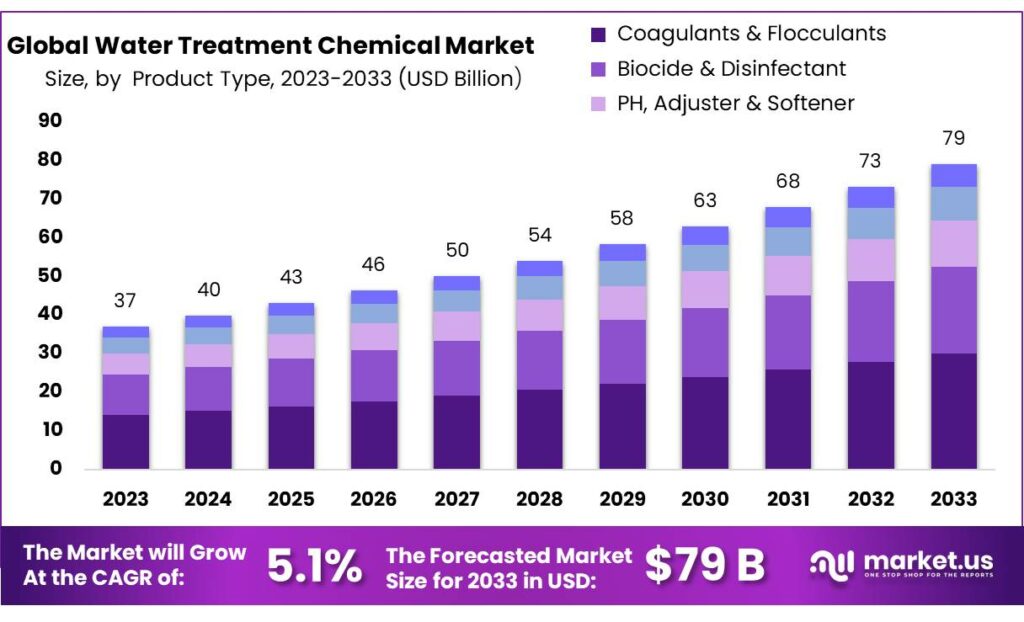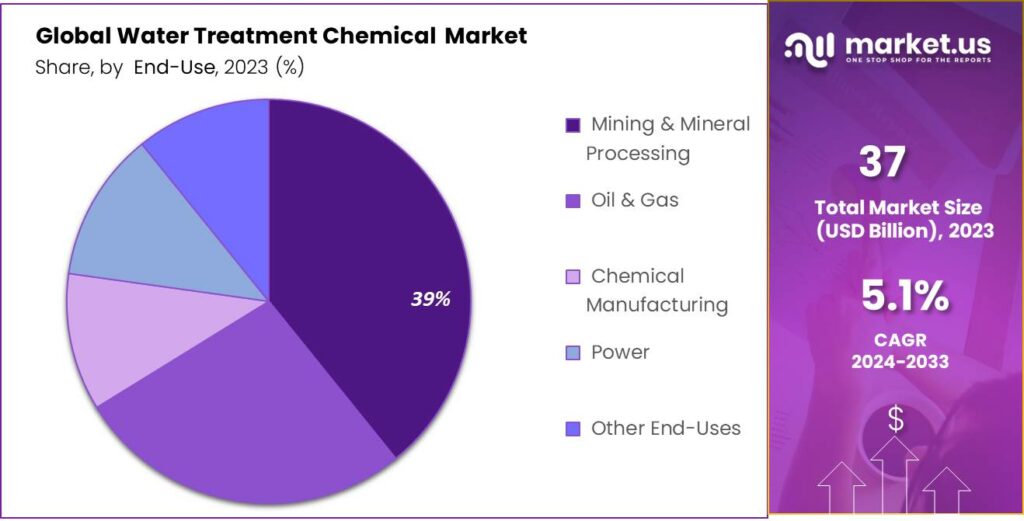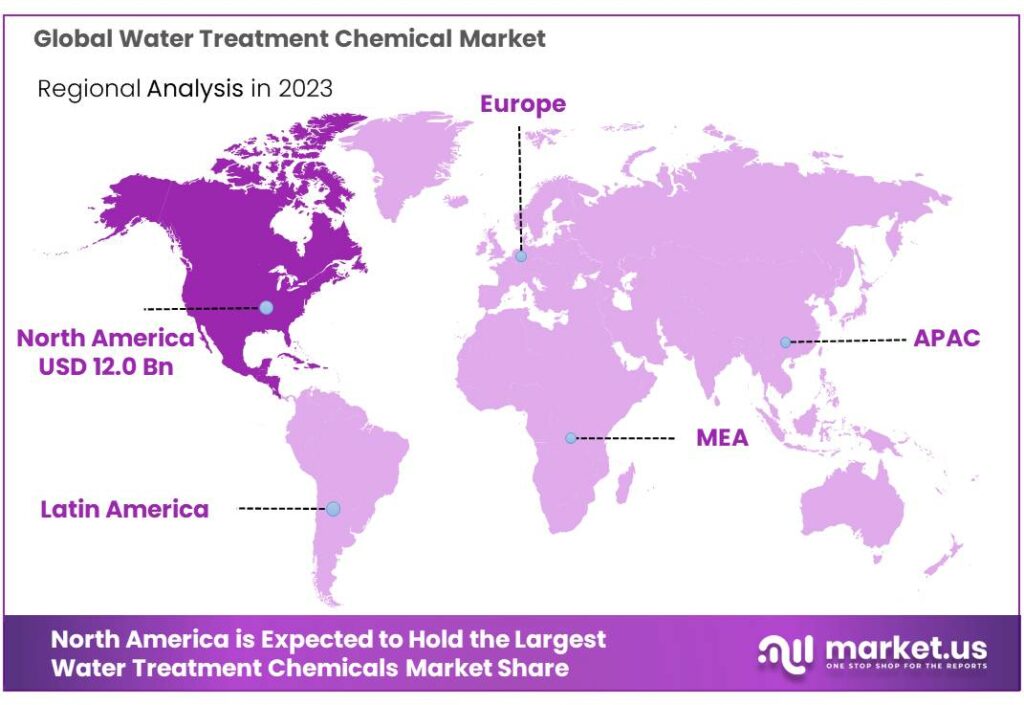Global Water Treatment Chemicals Market By Product Type (Coagulants and Flocculants, Biocide and Disinfectant, pH, and Other product types), By End-Use (Power, Oil & Gas, Chemical Manufacturing, and Other End-Uses) and by Region and Companies Industry Segment Outlook, Market Assessment, Competition Scenario, Trends and Forecast 2023-2033
- Published date: Nov 2023
- Report ID: 31750
- Number of Pages: 328
- Format:
- keyboard_arrow_up
Quick Navigation
Market Overview
The global water treatment chemicals market size is expected to be worth around USD 79 billion by 2033, from USD 37 billion in 2023, growing at a CAGR of 5.1% during the forecast period from 2023 to 2033.
This is due to the growing demand for sugar, ethanol, fertilizers, and geothermal energy. Due to the increasing use of saline treatment to meet rising water demands, the market will see promising growth in Africa and the Middle East. Desalination is the most used technology in the Middle East.
Saudi Arabia heavily relies on desalination for its water supply. The region is a significant consumer of industrial chemicals due to its high water use for oil and gas industries. The most common process in the region is desalination. It makes use of large-scale scale inhibitors and coagulants.

*Actual Numbers Might Vary In The Final Report
Key Takeaways
- Market Growth Projection: The global water treatment chemicals market is anticipated to grow from USD 37.7 billion in 2023 to around USD 62.0 billion by 2033, exhibiting a Compound Annual Growth Rate (CAGR) of 5.1%.
- Driving Factors: Industrial Demand: Increasing demand from industries like oil & gas, power, chemicals, and food & beverage fuels the need for chemically treated water for efficient recycling. Global Water Scarcity With only 2.5% of the world’s water being freshwater, there’s a rising need for effective water treatment chemicals. Emerging Economies Rapid urbanization in regions like Asia Pacific, especially in China and India, creates a significant demand for clean water solutions.
- Product Types and Usage: Coagulants & Flocculants: Form a significant part of the market (over 38.1% revenue in 2023), crucial in oil and gas industries for wastewater treatment Biocides & Disinfectants: Important for maintaining manufacturing efficiency and treating wastewater in industries like sugar, ethanol, and water treatment.
- End-Use Segments: Municipal: Largest segment due to high usage in municipal wastewater treatment, driven by increasing water scarcity in developed countries. Oil & Gas: Significant sector due to high wastewater generation in petroleum refineries and chemical plants.
- Challenges: Eco-Friendly Formulations: Struggling to balance environmental concerns with the need for effective and economically friendly chemicals. Patent Vulnerability: Copied patented chemicals in the market pose a challenge for original manufacturers.
- Region Analysis: North America: Holds a significant share (more than 32.2% in 2023) due to increased water treatment plants in the oil and gas sector.
- Key Players: SUEZ, BASF SE, Ecolab, Solenis, Nouryon, among others, are major players in the water treatment chemicals market.
Product Type Analysis
In oil and gas plants, tanks hold chemical products like coagulants and flocculants. In 2023, coagulants and flocculants made up the biggest chunk, with more than 38.1% of the revenue. Coagulants come in organic and inorganic forms, including things like aluminum sulfate or aluminum hydroxide chlorine.
It is crucial to control microbiological activity during manufacturing and industrial processes. Biocides and disinfectants are second in popularity because they help maintain manufacturing efficiency and protect manufacturing systems. They reduce the risk of contamination and prevent dangerous microbial growth. They can be used to maintain water conditions for food, water wastewater, and treated water.
They are used in the sugar, ethanol, and water treatment industries to properly treat wastewater. Biocides are also used to control bacteria in the ethanol fermentation process.
End-Use Analysis
Due to the increasing water scarcity in North America, Europe, and other developed countries, major players have switched to recycling and reusing water. With more than 39.2% revenue share, municipal emerged as the largest end-use segment in 2023. This is largely due to the high use of chemicals for municipal wastewater treatment.
Due to the rising costs of municipal waste treatment, industrialists were encouraged to establish or improve wastewater treatment and reuse facilities. Fluid treatment can include emulsion breaking and flocculation as well as sludge elimination.
Oil and gas have become a major end-use sector due to their high use in oil refineries and subsequent high wastewater generation. Petroleum refineries and chemical plants use steam and water for various processes, including desalination, fluid catalyst cracking units, and cooling towers.
Chemical plants and petroleum refineries need water treatment to work well and stay sustainable. This will make the oil and natural gas industry need more chemicals in the future.

*Actual Numbers Might Vary In The Final Report
Key Market Segments
By Product Type
- Coagulants & Flocculants
- Biocide & Disinfectant
- pH, Adjuster & Softener
- Defoaming Agent & Defoamer
- Other product types
By End-Use
- Power
- Oil & Gas
- Chemical Manufacturing
- Mining & Mineral Processing
- Other End-Uses
Driving Factors
Increasing demand for chemically treated water in various end-use industries
Only 2.5% of the world’s water is freshwater, creating a big problem for industries and homes. To tackle the increasing gap between what we need and what we have, using water treatment chemicals for efficient water recycling is crucial. Industries like oil & gas, power, pulp & paper, mining, chemicals, and food & beverage are quickly adopting treated wastewater.
In countries like China, India, Brazil, Indonesia, Malaysia, Argentina, Chile, and Vietnam, where industries are growing fast, the demand for clean water for homes, farms, and industries is rising. Water treatment chemicals are a cost-effective solution, beating pricier methods like ion exchange, UV filtration, and reverse osmosis. Big water treatment plants find coagulation, flocculation, and disinfection costs much lower than UV and RO options.
The growth of power, oil & gas, mining, and chemical industries, especially in places like China and India, is driving the demand for these chemicals. Projects like Brazil’s pre-salt oil fields and the building of high-capacity power plants globally using fossil fuels, nuclear, or solar power are also boosting the market for water treatment chemicals.
Restraining Factors
Alternative water treatment technologies
Different ways of treating water are becoming popular because they’re more eco-friendly and cheaper, slowing down the growth of the traditional water treatment chemicals market. Membrane filtration systems, for example, can precisely remove contaminants without using chemicals, improving water quality and reducing the need for traditional additives.
Ultraviolet (UV) disinfection is another eco-friendly method that kills pathogens without chemicals, addressing environmental worries and cutting down on the costs of buying and disposing of traditional treatment chemicals. Membrane filtration technologies, like microfiltration, ultrafiltration, nanofiltration, and reverse osmosis, offer a specialized approach to cleaning water by removing particles, microorganisms, and dissolved solutes.
These systems are praised for using fewer chemicals, which is better for the environment and saves money. As industries focus more on being sustainable and cost-effective, the shift to these new and environmentally friendly water treatment methods might slow down the traditional water treatment chemicals market.
Opportunity
Rising population and rapid urbanization in emerging economies
Big chances are popping up for the water treatment chemicals market in the Asia Pacific region, especially in China and India. China, dealing with a big population and not much freshwater, is putting a spotlight on water quality in its Five-Year Plan for Ecological & Environmental Protection. The government’s focus on managing water quality, controlling pollution, and improving urban water bodies creates a strong demand for water treatment chemicals.
In India, where there’s not a lot of freshwater compared to the population, the need for clean water for farming and industries is clear. With 16% of the world’s people, India is a huge market for water treatment solutions. As cities grow and people worry more about the environment, these countries are great opportunities for water treatment chemicals to tackle water quality problems and meet the growing demand. It’s an exciting chance for the industry to grow.
Challenge
Need for eco-friendly formulations and vulnerability regarding copying patents
A big hurdle for the water treatment chemicals market is the strict environmental rules from agencies like the EPA. Worries about how chemicals affect the environment have led to tough rules for companies making water treatment chemicals. Now, these companies are pushed to use greener options, but it’s tough because the green alternatives don’t perform as well in tough conditions.
Manufacturers struggle with the costs and profits of green chemistry, making it hard to create effective and economically friendly water treatment chemicals. Using green alternatives also brings the risk of bio-fouling, needing extra biocides that affect cost-efficiency.
Water treatment chemicals need to be stronger for more recycling, but stronger chemicals are usually less eco-friendly. When a patented water treatment chemical is shared with the public, it can be copied. Some Asian manufacturers sell fake products at lower prices, creating a big challenge for basic chemical makers.
Region Analysis
In 2023, North America held more than 32.2% of the market. Hydraulic fracturing has led to an increase in unconventional sources such as tight oil and shale in North Dakota and West Texas. This has resulted in a greater penetration of water treatment plants within the upstream oil and gas sector. This will have a positive effect on the market over the forecast period.
Over the forecast period, the U.S. will grow at a 2.4% CAGR. This is possible because of strict regulations governing the disposal and production of wastewater. According to the International Trade Administration (ITA), the United States is a leader in energy production, consumption, and supply (presence of thermoelectric power plants). The U.S. Power Industry’s rising demand for chemicals to treat water will positively impact market growth.
The demand for boiler chemicals will rise in Asia Pacific’s emerging economies due to increased manufacturing, industrial, and power sector growth. China is increasingly looking for pretreated water due to high heavy metals and suspended parts.
China Water Risk (CWR) works for several government agencies in China and worldwide. CWR reports on the risks and impacts of wastewater in China’s agricultural, power, food, and textile industries. CWR reports help address problems and contribute to water treatment efforts.

Key Regions and Countries
- North America
- US
- Canada
- Mexico
- Europe
- Germany
- UK
- France
- Italy
- Russia
- Spain
- Rest of Europe
- APAC
- China
- Japan
- South Korea
- India
- Rest of Asia-Pacific
- South America
- Brazil
- Argentina
- Rest of South America
- MEA
- GCC
- South Africa
- Israel
- Rest of MEA
Key Players Analysis
Market fragmentation is a fact of life. Manufacturers are known for their high degree of integration. There are in-house production facilities for raw materials and long-term supply agreements between raw material suppliers.
Companies sell their products on both the domestic and international markets through various distribution channels including direct supply agreements and third-party suppliers. These suppliers not only buy the final products from the manufacturer but also distribute them throughout the region via a large product distribution network.
Businesses can now supply directly, manufacture, distribute, apply, and have control over the final product. Companies have seen increased profits due to their involvement at every stage of the value chain. This has allowed them to lower the cost of distribution and allow them to better manage the pricing of the products. Here are the top players in the water treatment chemicals market:
Маrkеt Key Рlауеrѕ
- SUEZ
- BASF SE
- Ecolab
- Solenis
- Nouryon
- Kemira Oyj
- Dow Chemical Company
- SNF Group
- Cortec Corporation
- Buckman
- Solvay S.A.
- Other Key Players
Recent Development
October 2023: Solenis took over CedarChem’s headquarters in Cedartown, Georgia. CedarChem specializes in water and wastewater treatment products for industrial and municipal use, mainly in the southeastern US. This acquisition boosts Solenis’ position in the US market.
December 2021: Ecolab Inc. successfully completed the acquisition of Purolite, a global provider of ion exchange resins used in pharmaceutical and industrial applications. Purolite, based in the US, operates in over 30 countries.
Report Scope
Report Features Description Market Value (2022) US$ 37 Bn Forecast Revenue (2032) US$ 79 Bn CAGR (2023-2032) 5.1% Base Year for Estimation 2022 Historic Period 2016-2022 Forecast Period 2023-2032 Report Coverage Revenue Forecast, Market Dynamics, COVID-19 Impact, Company Profiles, Recent Developments Segments Covered By Product Type (Coagulants and flocculants, Biocide and disinfectant, pH, and Other product types), By End-Use (Power, Oil and gas, Chemical Manufacturing, and Other End-Uses) Regional Analysis North America – The US, Canada, & Mexico; Western Europe – Germany, France, The UK, Spain, Italy, Portugal, Ireland, Austria, Switzerland, Benelux, Nordic, & Rest of Western Europe; Eastern Europe – Russia, Poland, The Czech Republic, Greece, & Rest of Eastern Europe; APAC – China, Japan, South Korea, India, Australia & New Zealand, Indonesia, Malaysia, Philippines, Singapore, Thailand, Vietnam, & Rest of APAC; Latin America – Brazil, Colombia, Chile, Argentina, Costa Rica, & Rest of Latin America; The Middle East & Africa – Algeria, Egypt, Israel, Kuwait, Nigeria, Saudi Arabia, South Africa, Turkey, United Arab Emirates, & Rest of MEA. Competitive Landscape SUEZ, BASF SE, Ecolab, Solenis, Nouryon, Kemira Oyj, Dow Chemical Company, SNF Group, Cortec Corporation, Buckman, Solvay S.A., Other Key Players. Customization Scope Customization for segments, region/country-level will be provided. Moreover, additional customization can be done based on the requirements. Purchase Options We have three licenses to opt for: Single User License, Multi-User License (Up to 5 Users), Corporate Use License (Unlimited User and Printable PDF). Frequently Asked Questions (FAQ)
How big is water treatment chemicals market?water treatment chemicals market size is expected to be worth around USD 62.0 billion by 2033, from USD 37.7 billion in 2023
List the key industry players of the Water Treatment Chemicals Market?SUEZ, BASF SE, Ecolab, Solenis, Nouryon, Kemira Oyj, Dow Chemical Company, SNF Group, Cortec Corporation, Buckman, Solvay S.A., Other Key Players.
What is the projected CAGR at which the Water Treatment Chemicals Market is expected to grow at?The Water Treatment Chemicals Market is expected to grow at a CAGR of 5.1% (2023-2033). Water Treatment Chemicals MarketPublished date: Nov 2023add_shopping_cartBuy Now get_appDownload Sample
Water Treatment Chemicals MarketPublished date: Nov 2023add_shopping_cartBuy Now get_appDownload Sample - SUEZ
- BASF SE
- Ecolab
- Solenis
- Nouryon
- Kemira Oyj
- Dow Chemical Company
- SNF Group
- Cortec Corporation
- Buckman
- Solvay S.A.
- Other Key Players
- settingsSettings
Our Clients
| Single User $4,599 $3,499 USD / per unit save 24% | Multi User $5,999 $4,299 USD / per unit save 28% | Corporate User $7,299 $4,999 USD / per unit save 32% | |
|---|---|---|---|
| e-Access | |||
| Report Library Access | |||
| Data Set (Excel) | |||
| Company Profile Library Access | |||
| Interactive Dashboard | |||
| Free Custumization | No | up to 10 hrs work | up to 30 hrs work |
| Accessibility | 1 User | 2-5 User | Unlimited |
| Analyst Support | up to 20 hrs | up to 40 hrs | up to 50 hrs |
| Benefit | Up to 20% off on next purchase | Up to 25% off on next purchase | Up to 30% off on next purchase |
| Buy Now ($ 3,499) | Buy Now ($ 4,299) | Buy Now ($ 4,999) |












